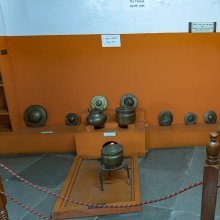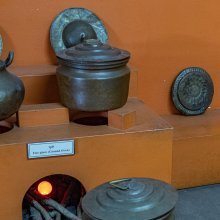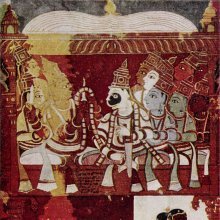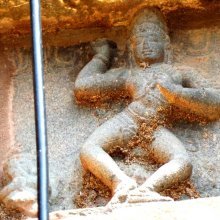Tim, Ṭhīṃ: 10 definitions
Introduction:
Tim means something in Hinduism, Sanskrit, biology, Tamil. If you want to know the exact meaning, history, etymology or English translation of this term then check out the descriptions on this page. Add your comment or reference to a book if you want to contribute to this summary article.
Images (photo gallery)
Biology (plants and animals)
Source: Google Books: CRC World Dictionary (Regional names)1) Tim in Ghana is the name of a plant defined with Pterocarpus erinaceus in various botanical sources. This page contains potential references in Ayurveda, modern medicine, and other folk traditions or local practices It has the synonym Lingoum erinaceum (Poir.) Kuntze (among others).
2) Tim in Ivory Coast, Burkina Faso is also identified with Ficus sur It has the synonym Urostigma thonningii Miq. (etc.).
Example references for further research on medicinal uses or toxicity (see latin names for full list):
· Flora de Filipinas (1877)
· Journal of Ethnopharmacology (2003)
· Fitoterapia (2001)
· Journal of Ethnopharmacology (1990)
· Phytotherapy Research (2003)
· Economic Botany (1964)
If you are looking for specific details regarding Tim, for example chemical composition, side effects, health benefits, pregnancy safety, extract dosage, diet and recipes, have a look at these references.

This sections includes definitions from the five kingdoms of living things: Animals, Plants, Fungi, Protists and Monera. It will include both the official binomial nomenclature (scientific names usually in Latin) as well as regional spellings and variants.
Languages of India and abroad
Sanskrit dictionary
Source: Cologne Digital Sanskrit Dictionaries: Shabda-Sagara Sanskrit-English DictionaryTim (तिम्).—[tima] r. 4th cl. (timyati) To be or become wet, damp, &c. E. divā0 pa0 saka0 seṭ .
--- OR ---
Tīm (तीम्).—[tīma] r. 4th cl. (tīmyati) To be wet or moist: see tima . divā0 pa0 aka0 seṭ .
Source: Cologne Digital Sanskrit Dictionaries: Benfey Sanskrit-English DictionaryTim (तिम्).—i. 4, [Parasmaipada.] To become wet, [Hitopadeśa] 79, 5 Seramp. Ptcple. of the pf. pass. timita, Unmoved, [Rāmāyaṇa] 5, 1, 26.
— Cf. stim.
--- OR ---
Tīm (तीम्).—i. 4, [Parasmaipada.] = tim.
Source: Cologne Digital Sanskrit Dictionaries: Cappeller Sanskrit-English DictionaryTim (तिम्).—timyati [participle] timita become quiet (or *damp*).
Source: Cologne Digital Sanskrit Dictionaries: Monier-Williams Sanskrit-English Dictionary1) Tim (तिम्):—(= √stim) [class] 4. [Parasmaipada] myati, to become quiet, [Hitopadeśa];
—to become wet (also tīmy [from] √tīm), [Dhātupāṭha] :—[Intensive] tetimyate, [Pāṇini 7-4; Kāśikā-vṛtti]
2) Tīm (तीम्):—[class] 4. myati See √tim:
2) —[Causal] tīmayati, to wet, [Divyāvadāna xix.]
Source: Cologne Digital Sanskrit Dictionaries: Yates Sanskrit-English Dictionary1) Tim (तिम्):—(ya) timyati 4. a. To be wet.
2) Tīm (तीम्):—(ya) tīmyati 4. a. To be wet.
Source: DDSA: Paia-sadda-mahannavo; a comprehensive Prakrit Hindi dictionary (S)Tim (तिम्) in the Sanskrit language is related to the Prakrit words: Tiṇṇa, Tiṇṇāai, Timma.
[Sanskrit to German]
Sanskrit, also spelled संस्कृतम् (saṃskṛtam), is an ancient language of India commonly seen as the grandmother of the Indo-European language family (even English!). Closely allied with Prakrit and Pali, Sanskrit is more exhaustive in both grammar and terms and has the most extensive collection of literature in the world, greatly surpassing its sister-languages Greek and Latin.
Tamil dictionary
Source: DDSA: University of Madras: Tamil LexiconTīm (தீம்) cf. தேம். [them.] noun (திவா. [thiva.])
1. Sweetness, pleasantness; இனிமை. தீங்கதிர்த் தோற்றமென் னவே [inimai. thingathirth thorramen nave] (சீவகசிந்தாமணி [sivagasindamani] 2419).
2. Nectar; அமுது. [amuthu.] — adjectival Sweet; இனிய. நெருநலுந் தீம்பல மொழிந்த [iniya. nerunalun thimbala mozhintha] (அகநா. [agana.] 239).
--- OR ---
Tim (திம்) noun cf. தேம். [them.] Direction; திக்கு. (யாழ்ப்பாணத்து மானிப்பாயகராதி) [thikku. (yazhppanathu manippayagarathi)]
Tamil is an ancient language of India from the Dravidian family spoken by roughly 250 million people mainly in southern India and Sri Lanka.
See also (Relevant definitions)
Starts with (+309): Ti-muranpaccai, Tim lang, Tim mu sa, Tima, Tima tima, Timadia, Timahi, Timai, Timajala, Timaka, Timaki, Timal, Timali, Timam, Timana, Timanam, Timanda, Timanem, Timanna, Timano.
Ends with (+44): Ahamantim, Anoshipotim, Antecatim, Antim, Antutim, Apratim, Aracavatim, Ardhapotim, Atirattim, Avatimbhavatim, Ayatim, Bagauakitim, Bara Balatim, Bhamvatim, Bhantimbhantim, Bhantobhantim, Bhavatim, Bhotim, Bilde mariang itim, Centim.
Full-text (+576): Tiṇṇa, Tema, Timita, Timma, Atejas, Temeti, Timpantam, Timayati, Durdarsha, Timpulal, Timira, Ti, Thap-thim, Bhramatra, Samyaksambodhi, Tim lang, Ceyyar, Niruc, Tim mu sa, Gaso las tim.
Relevant text
Search found 129 books and stories containing Tim, Tīm, Thim, Dim, Dhim, Theem, Ṭhīṃ; (plurals include: Tims, Tīms, Thims, Dims, Dhims, Theems, Ṭhīṃs). You can also click to the full overview containing English textual excerpts. Below are direct links for the most relevant articles:
Rig Veda (translation and commentary) (by H. H. Wilson)
Vakyapadiya of Bhartrihari (by K. A. Subramania Iyer)
Verse 3.14.616 < [Book 3 - Pada-kāṇḍa (14): Vṛtti-samuddeśa (On Ccomplex Formation)]
Verse 1.102 < [Book 1 - Brahma-kāṇḍa (or Āgama-samuccaya)]
Guhyagarbha Tantra (with Commentary) (by Gyurme Dorje)
Text 18.6 (Commentary) < [Chapter 18 (Text And Commentary)]
Text 7.16 (Commentary) < [Chapter 7 (text and commentary)]
Text 10.6 (Commentary) < [Chapter 10 (Text and Commentary)]
Sahitya-kaumudi by Baladeva Vidyabhushana (by Gaurapada Dāsa)
Text 10.123 < [Chapter 10 - Ornaments of Meaning]
Text 10.69 < [Chapter 10 - Ornaments of Meaning]
Paṇḍita-rāja Jagannātha < [Introduction]
The Garuda Purana (by Manmatha Nath Dutt)
Chapter CCXXXIII - Naimittika Pralaya, etc. < [Dhanvantari Samhita]
Chapter CLXXI - The Nidanam of diseases of the eyes < [Dhanvantari Samhita]
Manusmriti with the Commentary of Medhatithi (by Ganganatha Jha)
Verse 3.191 < [Section X - Method of Invitation]
Verse 3.68 < [Section VII - Duties of the Householder]
Verse 2.189 < [Section XXX - Rules to be observed by the Religious Student]



